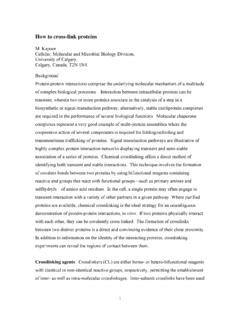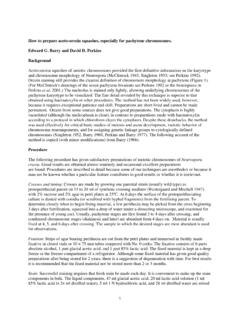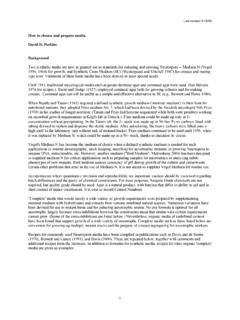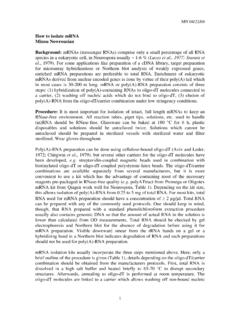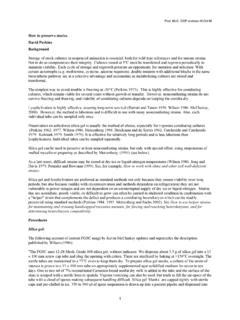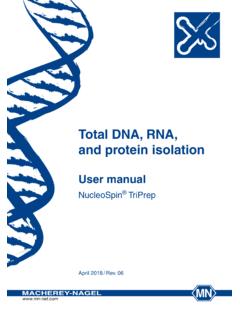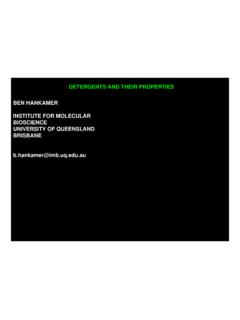Transcription of How to isolate proteins - Fungal Genetics Stock …
1 how to isolate proteins Manju Kapoor Background Numerous authoritative books, excellent reviews and articles have been written on this subject. While general methods for isolation and purification of proteins are applicable to all organisms, it is invariably necessary to develop unique strategies for isolation of the target protein of interest. Unlike research with DNA, no manual of standard protocols or recipes is available, outlining a stepwise approach applicable to all proteins . Furthermore, there are no organism-specific procedures that can allow one to plan a course of action with a predictable outcome.
2 protein purification has been described as more of an art than a science . The design of an appropriate procedure for isolation of a given protein should be tailored in accordance with the objective(s) of the research project, which may require relatively pure product in modest amounts for analytical purposes ( enzyme kinetics) or a highly purified, homogeneous preparation for physicochemical or structural studies. Isolation and purification of a single protein from cells containing a mixture of thousands of unrelated proteins is achievable because of the remarkable variation in the physical and chemical attributes of proteins .
3 Characteristics unique to each protein amino acid composition, sequence, subunit structure, size, shape, net charge, isoelectric point, solubility, heat-stability, hydrophobicity, ligand/metal binding properties and post-translational modifications can be exploited in formulation of a strategy for purification . Based on these properties a combination of various methods, listed below, can be used for separation of cellular proteins (Refs 1, 2). Procedure Separation Method Property 1.
4 Precipitation Ammonium sulfate Solubility Polyethylene glycol Solubility 2. Chromatography Ion-exchange (anion or cation) Net charge 1 Hydrophobic interaction Surface hydrophobicity Metal affinity Metal-binding sites Ligand affinity Ligand-binding sites ( NAD, NADP) Gel filtration Subunit/oligomer size, shape 3.
5 Centrifugation Size, shape Generic outline for protein purification In general, protein purification entails essentially five types of steps: 1) efficient extraction from biological material; 2) separation from non- protein components (nucleic acids and lipids); 3) precipitation steps, initially to recover the bulk protein from a crude extract, followed by preliminary resolution into manageable fractions; 4) use of ion-exchange chromatography/size fractionation or hydrophobic chromatography columns to further separate the target protein -containing fraction from the bulk protein ; 5) a more refined set of steps including an affinity matrix to enable recovery of the target protein in a highly purified state along with a high yield.
6 A variety of agarose-based matrices with immobilized reactive dyes, covalently bound nucleotides, metals and numerous other ligands are commercially available (supplied by Sigma, Amicon, etc.). In order to evaluate the progress of purification , a convenient assay procedure based on enzymatic activity or some other easily monitored property specific to the protein should be available. A spectrophotometric or colorimetric method for enzymatic activity measurement is most convenient and a progressive increase in specific activity (for enzymes, activity in units /mg protein ) is an excellent indicator of the efficacy of the purification step.
7 For proteins lacking a readily measurable biological activity, it may be feasible to use an immunochemical procedure such as western blotting or ELISA (Enzyme-Linked-Immuno-sorbent Assay), provided suitable antibodies are available. In this case, electrophoretic resolution of the protein population in samples at each stage of purification will be required. purification of native proteins While purification of the native proteins is a challenging exercise, several reliable approaches have stood the test of time.
8 Compared to soluble proteins , membrane-bound 2proteins are more difficult to purify. Solubilization of membrane proteins can be achieved by the use of detergents but removal of the detergent is necessary for subsequent analytical manipulations. A detailed treatment of the properties of various detergents and their applications is available in reference 1. In the following a representative procedure for purification of soluble Neurospora proteins is outlined. 1. Preparation of crude extracts: Efficient extraction of the total protein from the starting material is vital for success of any purification procedure.
9 Complete disruption of cells and release of contents from cellular debris is the most important step in the process. For purification of Neurospora proteins in the native state, the first step involves the extraction of bulk protein fraction from mycelial cells. All steps in the procedure are carried out at 4 C to minimize protein degradation. Mycelial cultures are grown for 18 to 20 h in a medium conducive to optimal production of the target protein , harvested, lyophilized and stored at 70oC.
10 Ten to 20 g of lyophilized mycelial powder is suspended in 10 volumes of an extraction buffer (50 mM Tris-HCl, pH , mM EDTA, 1 mM -mercaptoethanol or dithiothreitol) and the mixture is stirred for 45 min in the cold room. The presence of EDTA serves to inhibit protease action and -mercaptoethanol (or DTT) is necessary for maintenance of a reducing environment. This slurry is homogenized using a glass homogenizer and the homogenate is centrifuged at 12 000 x g for 20 min (to remove cellular debris) in a refrigerated Centrifuge.
